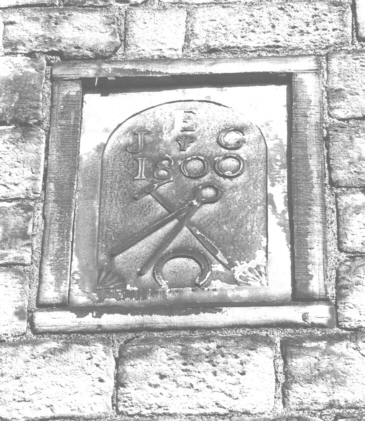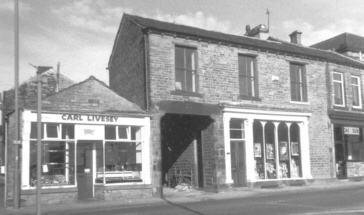Page revised 21 August
2001
EDWARD LAW
HUDDERSFIELD &
DISTRICT HISTORY
THE
GLEDHILL FAMILY OF LINDLEY AND THEIR BUILDINGS.
Edward J Law
27 February 1798 is a
significant date in Lindley's history for on that day an award1
was drawn up which divided and allotted the open, or common,
fields of the village to the fourteen individuals who then held
land within them. The award also set out the line of new highways
amid the allotments, to the south of the then village, along
which development soon followed.
This article is concerned with an
allotment made to Thomas Firth of Lindley, cornfactor, a Quaker.
The land which lay adjacent to existing crofts, or enclosed
holdings, at the southern extremity of Lidgate (Lidget) Lane was
known as Croft End. In February 1800 Thomas Firth sold 272 square
yards of the allotment to Joseph Gledhill2, a
blacksmith, who is first noted in the village in 1791 when a son,
Freeman, was baptised at Salendine Nook Baptist Chapel3;
his first son, Martin, had been baptised in 1789 when the family
were stated to have been of Hill Top4. Freeman must
have died for six years later Joseph and his wife baptised a
"second Freeman", they also called one of their
daughters Freemy. There was clearly an attachment to this name,
probably through some family connection for it was also used in
the family of his in-laws. The Baptist connection may have come
with his marriage5 in 1788 to Elizabeth Morton, one of
a family who were instrumental in founding the chapel at
Salendine Nook.
 Having purchased
the land in Lindley Joseph proceeded to erect on it a cottage and
a blacksmith's shop. The central building of this early
development upon the old open fields, which incorporates a most
interesting date-stone, still stands. The stone bears the
initials E J G, for Elizabeth and Joseph Gledhill, and the date
of the building, 1800, over motifs of the blacksmith's trade:
hammer, tongs and horseshoe. A development of the following year
which also resulted from the enclosure of Lindley Town fields was
the property Daisy Lea, built by Thomas Hirst who lived at Beggar
Style or Croft House as it became known.
Having purchased
the land in Lindley Joseph proceeded to erect on it a cottage and
a blacksmith's shop. The central building of this early
development upon the old open fields, which incorporates a most
interesting date-stone, still stands. The stone bears the
initials E J G, for Elizabeth and Joseph Gledhill, and the date
of the building, 1800, over motifs of the blacksmith's trade:
hammer, tongs and horseshoe. A development of the following year
which also resulted from the enclosure of Lindley Town fields was
the property Daisy Lea, built by Thomas Hirst who lived at Beggar
Style or Croft House as it became known.
Joseph Gledhill's property lies at
the heart of the present village, in the yard beside Carl Livesey's
butcher's shop, hidden from view by a subsequent development of
the Gledhill family.
Established on his own freehold,
Joseph apparently prospered, for he continued to expand the
holding. In 1814 he purchased6 a further 108 square
yards of the allotment from Thomas Firth, for úl3. 13s. 0d. upon
which he built two more cottages and another blacksmith's shop.
By that time his two sons would have joined him in his trade,
Martin had married and given him a grandson7, Gideon,
and his other son, Freeman, was seventeen. When Joseph died some
ten years later Freeman, who in 1824 had married Maria Morton8,
had removed to Outlane, and Martin succeeded to the business.
Martin appears to have been dead by
1841 when the census shows Gideon Gledhill, blacksmith, living in
Temple Street, and with him Calvin Gledhill, blacksmith, and
Joseph Martin, blacksmith's apprentice. In that year there were
four families living at Croft End, the head of one being yet
another blacksmith, William North. Smithies which could occupy
three blacksmiths must have been a centre of village life on
working days with carriers, farmers and tradesmen calling to have
their horses shod or their implements repaired, and we may
imagine that Lidget Street was not often free of the ringing of
hammer on anvil.
Martin had left his real estate to
Gideon9, but a small rent charge was secured to his
widow, Elizabeth, who removed to Dewsbury, and when Gideon wished
to borrow money upon the estate he had to make a settlement with
his step-mother to release her interest.
Gideon was a member of the
established church and was for many years the organist and
choirmaster of St. Stephen's, Lindley Parish Church, where he is
commemorated on a tablet within the church, and buried along with
other members of his family.
By the 1850s the area to the north
of Temple Street which comprised the Gledhill freehold had become
known, appropriately, as Smithy Fold, and at the end of the
decade Gideon redeveloped the  eastern side of
the estate, erecting a modern two-storey building on which his
initials and the date 1859 may still be seen. The new block (shown
here), which dwarfed and hid from view the original building
which his grandfather had erected, may have marked a transition
from the traditional trade of blacksmith to a retailer, for the
ground floor of the premises comprised two shops fronting onto
Lidget Street, and Gideon and his successors are noted from 1867
not as blacksmiths but as ironmongers.
eastern side of
the estate, erecting a modern two-storey building on which his
initials and the date 1859 may still be seen. The new block (shown
here), which dwarfed and hid from view the original building
which his grandfather had erected, may have marked a transition
from the traditional trade of blacksmith to a retailer, for the
ground floor of the premises comprised two shops fronting onto
Lidget Street, and Gideon and his successors are noted from 1867
not as blacksmiths but as ironmongers.
In 1870, the year before his death,
Gideon was described10 as an ironmonger and machine
maker and it appears that the different facets of his business
were then split. In 1873 two of his sons, John, the eldest, and
Edwin Gledhill were recorded as crane and machine manufacturers
and the ironmongery was being conducted by the executors of
Gideon Gledhill11, probably on behalf of his son
Stephen Wilkinson Gledhill, then under age, who is shown as the
proprietor from 1879. The family were no longer noted as
blacksmiths, but George Dyson who is recorded as a blacksmith in
directories of the 1870s was Gideon's cousin, another grandson of
Joseph and Elizabeth Gledhill.
The new premises which John and
Edwin erected for the manufacture of cranes and machinery are now
part of the concerns of a major insurance broke., lying to the
south of Temple Street, and their erection is commemorated in a
key-stone inscribed J & E G 1878. As with many industrialists
of the period the two partners made their homes close to their
business. John who died in 1940 at the age of 95 lived at 5
Temple Street, a substantial double-fronted house the back of
which looks onto the works, and Edwin also lived in Temple Street.
The business continued in St. Stephen's Ironworks, as the
building was known, down to 1937.
| Acknowledgement: |
| The photograph of the date stone
courtesy of Huddersfield Examiner. |
SOURCES.
| 1 |
West Riding Registry of Deeds, Wakefield, B 24 339. |
| 2 |
West Riding Registry of Deeds, Wakefield, ED 280 376 |
| 3 |
Registers of Salendine Nook Baptist Chapel (microfilm),
Huddersfield Public Library, Local History Section. |
| 4 |
Ibid. |
| 5 |
Parish Registers of St Peter's, Huddersfield (microfilm),
Huddersfield Public Library, Local History Section. |
| 6 |
West Yorkshire Archives, Kirklees, KC165-109. |
| 7 |
IGI Fiche |
| 8 |
Ibid. |
| 9 |
West Riding Registry of Deeds, Wakefield, OT 138 121. |
| 10 |
Directory 1870. |
| 11 |
Directory 1873. |
Return to HOME.
 Having purchased
the land in Lindley Joseph proceeded to erect on it a cottage and
a blacksmith's shop. The central building of this early
development upon the old open fields, which incorporates a most
interesting date-stone, still stands. The stone bears the
initials E J G, for Elizabeth and Joseph Gledhill, and the date
of the building, 1800, over motifs of the blacksmith's trade:
hammer, tongs and horseshoe. A development of the following year
which also resulted from the enclosure of Lindley Town fields was
the property Daisy Lea, built by Thomas Hirst who lived at Beggar
Style or Croft House as it became known.
Having purchased
the land in Lindley Joseph proceeded to erect on it a cottage and
a blacksmith's shop. The central building of this early
development upon the old open fields, which incorporates a most
interesting date-stone, still stands. The stone bears the
initials E J G, for Elizabeth and Joseph Gledhill, and the date
of the building, 1800, over motifs of the blacksmith's trade:
hammer, tongs and horseshoe. A development of the following year
which also resulted from the enclosure of Lindley Town fields was
the property Daisy Lea, built by Thomas Hirst who lived at Beggar
Style or Croft House as it became known.  eastern side of
the estate, erecting a modern two-storey building on which his
initials and the date 1859 may still be seen. The new block (shown
here), which dwarfed and hid from view the original building
which his grandfather had erected, may have marked a transition
from the traditional trade of blacksmith to a retailer, for the
ground floor of the premises comprised two shops fronting onto
Lidget Street, and Gideon and his successors are noted from 1867
not as blacksmiths but as ironmongers.
eastern side of
the estate, erecting a modern two-storey building on which his
initials and the date 1859 may still be seen. The new block (shown
here), which dwarfed and hid from view the original building
which his grandfather had erected, may have marked a transition
from the traditional trade of blacksmith to a retailer, for the
ground floor of the premises comprised two shops fronting onto
Lidget Street, and Gideon and his successors are noted from 1867
not as blacksmiths but as ironmongers.